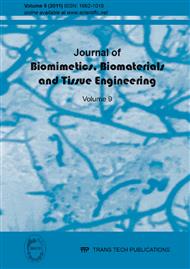p.1
p.17
p.25
p.37
p.47
p.57
p.69
p.81
p.93
Study on Influence of Implant Thickness and Fixation Position on Implant Stability Using Finite Element Analysis
Abstract:
Patient anatomy specific orthopaedic implant design, fabrication and identification of the most suitable position to fix implants onto bone fractures are challenging problems for surgeons to overcome of the existing shortcomings of commercially available implants. In this work, a 3D finite element model of the left tibial bone of an adult male is developed from Computed Tomography scan images. Proximal tibial fracture type B1 (as per Association for the Study of Internal Fixation) is simulated on the bone model. A geometry specific implant is obtained in order to promote better bone ingrowths and uniform stress distribution, by extracting the surface features of the bone. Finite Element Analysis is performed to evaluate and compare the mechanical properties such as stress, strain and displacement of the bone and implant of four various thicknesses which are fixed at two different positions. The design objectives such as low stress and displacement combination is obtained through the antero-lateral position with 1.8 mm implant thickness. Various material properties are assigned to cortical, cancellous, trabecular regions of the bone and to implants made up of titanium alloy. The results obtained from the Finite Element Analysis are used to evaluate the stability and suitability of the implant for that particular fracture.
Info:
Periodical:
Pages:
47-55
Citation:
Online since:
January 2011
Authors:
Price:
Сopyright:
© 2011 Trans Tech Publications Ltd. All Rights Reserved
Share:
Citation:


